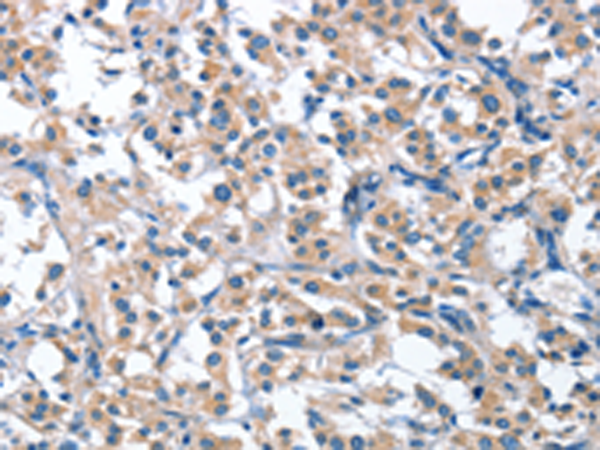

| WB | 咨询技术 | Human,Mouse,Rat |
| IF | 咨询技术 | Human,Mouse,Rat |
| IHC | 1/50-1/200 | Human,Mouse,Rat |
| ICC | 技术咨询 | Human,Mouse,Rat |
| FCM | 咨询技术 | Human,Mouse,Rat |
| Elisa | 1/1000-1/5000 | Human,Mouse,Rat |
| Aliases | ASB-2 |
| Host/Isotype | Rabbit IgG |
| Antibody Type | Primary antibody |
| Storage | Store at 4°C short term. Aliquot and store at -20°C long term. Avoid freeze/thaw cycles. |
| Species Reactivity | Human, Mouse, Rat |
| Immunogen | Fusion protein of human ASB2 |
| Formulation | Purified antibody in PBS with 0.05% sodium azide and 50% glycerol. |
+ +
以下是关于ASB2抗体的3篇代表性文献(内容基于公开研究整理,具体引用需核实原文):
---
1. **文献名称**:*ASB2α, an E3 Ubiquitin Ligase Specificity Subunit, Regulates Cell Migration*
**作者**:Guibal, F.C., et al.
**年份**:2002
**摘要**:研究报道ASB2α作为E3泛素连接酶的亚基,通过靶向vinculin等细胞骨架蛋白进行泛素化降解,调控细胞迁移。实验中利用ASB2抗体验证其在白血病细胞中的表达及功能,揭示其通过蛋白酶体途径影响细胞黏附与迁移。
---
2. **文献名称**:*The E3 ligase Asb2 regulates skeletal muscle mass via interaction with the Akt/mTOR pathway*
**作者**:Köhler, A., et al.
**年份**:2015
**摘要**:通过ASB2特异性抗体检测,发现ASB2在肌肉萎缩中高表达,并与Akt/mTOR信号通路相互作用,促进肌肉蛋白降解。该研究为ASB2抗体在肌肉疾病模型中的应用提供了证据。
---
3. **文献名称**:*ASB2 is a direct target of FLI1 in acute megakaryoblastic leukemia*
**作者**:Lin, S., et al.
**年份**:2007
**摘要**:研究发现ASB2在急性巨核细胞白血病中受转录因子FLI1调控,并通过ASB2抗体进行免疫沉淀和Western blot分析,证实其通过泛素化降解肿瘤抑制因子,促进白血病进展。
---
如需具体实验中的抗体应用细节(如抗体货号、验证方法),建议通过PubMed或抗体数据库(如CiteAb)进一步筛选。
The ASB2 antibody is designed to target the Ankyrin repeat and SOCS box protein 2 (ASB2), a member of the ASB family characterized by conserved ankyrin repeat domains and a C-terminal SOCS box motif. ASB2 functions as a substrate-recognition component of E3 ubiquitin ligase complexes, playing a role in ubiquitination-mediated protein degradation, which regulates cellular processes like signal transduction, differentiation, and apoptosis. It exists in two major isoforms, ASB2α and ASB2β, derived from alternative splicing, with ASB2α predominantly expressed in hematopoietic tissues and ASB2β in skeletal muscle.
Research highlights ASB2's involvement in cancer progression, particularly in leukemia and solid tumors, where it modulates cell migration, invasion, and metastasis by targeting proteins such as vinculin for degradation. Its expression is also linked to TGF-β signaling and immune response regulation. The ASB2 antibody is widely used in techniques like Western blotting, immunohistochemistry, and immunofluorescence to study its expression patterns, subcellular localization, and interaction partners. Understanding ASB2's role in disease mechanisms, especially its dual functions as a tumor suppressor or promoter depending on context, remains a key focus, making the antibody a valuable tool for both basic research and potential therapeutic development.
×